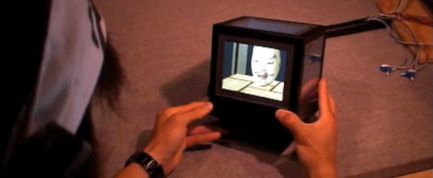Cool Handheld Cube Plays 3-D Movies

Instead of going to a movie theater for a 3-D video experience, you could soon hold one in your hand.
Researchers are developing a new electronic cube that enables interactive 3-D video without the need for glasses.
The device, called the personal Cubee, or pCubee, is light and compact enough to be held in one hand. It consists of five square flat panel LCD screens. Each panel is five-inches wide, and the set is arranged as a kind of fishtank box one can pick up, rotate, tilt, and shake to watch and manipulate the 3-D content within. For instance, users can play games with virtual objects that seem to be within the cube, such as rolling or bouncing a ball through a maze.
The system works by tracking the orientation and position of both the box and the user's head, using sensors in the cube and in a headset. With this knowledge, it skews the image on each screen so they all hopefully have the correct perspective from the user's point of view of the device in real-time.
Away from the user's viewpoint, the images on the screens look badly distorted, but for the user, the device can generate the illusion of looking into a box and seeing a miniature virtual world inside. Further manipulation of image shading, texture and shadows enhance cues of depth perception.
The device can also be paired with an electronic stylus. In this way, one can seemingly poke and prod objects inside the box, as well as select, paint or sculpt. (See 10 Profound Innovations Ahead.)
An immersive experience
Sign up for the Live Science daily newsletter now
Get the world’s most fascinating discoveries delivered straight to your inbox.
The pCubee is the handheld version of the Cubee, a roughly two-foot-wide original version of the device that can sit on a desk or be suspended by cables in the air.
"One of the reasons we moved to handheld was that when the 3-D display was fixed on the desk, it limited how one could move one's head for the 3-D effect when looking at images," said researcher Ian Stavness, a computer engineer at the University of British Columbia in Vancouver.
"The fact that it's handheld allows one to move one's head more to give the depth cues for the brain to perceive three dimensions."
Another benefit of making the device handheld is how it not only engages the body's sense of touch when a person holds it, but that it also engages the body's sense of proprioception, or perception of the position of one's body parts.
"The way objects inside seem to react to movements gives the feeling that an object really exists in there that one can have physical interactions with, which is a really compelling aspect of the 3-D effect," Stavness said.
Potential uses
In terms of applications, "one of the original motivations of the work concerned another project at our lab — creating 3-D models of human anatomy," Stavness explained. The pCubee could help doctors view 3-D MRI or CAT scan data, he noted.
For gaming, there is a strong recent push on platforms such as the iPhone for physics-based games that respond to a user's movements. When it comes to storytelling, "the principle behind pCubee is much more like watching a play in a theater than a movie on a screen," Stavness said. "One essentially has a diorama inside pCubee that one can inspect and gauge from different perspectives."
In museums, "you could imagine showing real artifacts as they are and then a digital representation of how it once was that you can pick up and hold in your hand," he added. "Just as with the audio players you often now see people walk around with at museums, you could carry around your own pCubee."
Architectural and computer-assisted design (CAD) projects could also benefit from the ability to see and manipulate blueprints in 3-D. "You might imagine a desktop-sized version for the higher resolution images one might want for those kinds of applications," Stavness noted. "You could also imagine having 3-D maps one could view."
In the future, the researchers plan to use slimmer organic LED (OLED) screens for lighter devices with better image quality and thinner seams on the box. Other directions could include the addition of wireless, zooming, touchscreens and a bottom screen. "You could also think of making it even smaller for kids," Stavness said.
"Right now we're looking [for] people to work with us for commercialization," Stavness added.
Stavness and his colleagues will detail their research April 13 at the CHI conference on human factors in computing systems in Atlanta.











